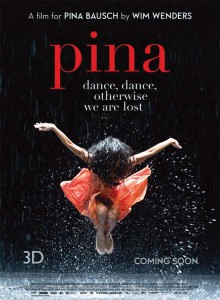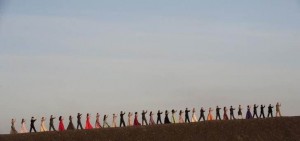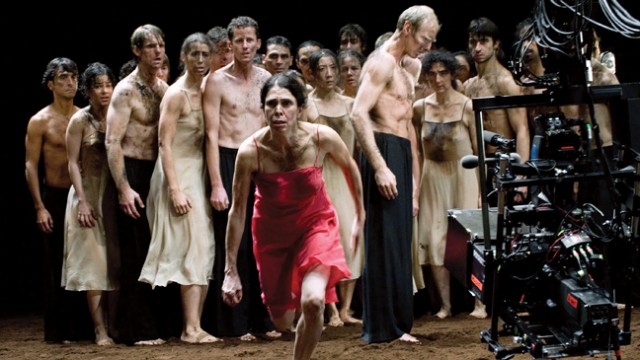 The namesake and subject of the German dance film Pina died rather unexpectedly from cancer shortly before the brilliant documentary began shooting, which caused a shift in the structure and focus of the piece. There is no real way of knowing exactly how the documentary would have turned out had this not been the case and the famous director of the German expressionist “Tanztheater” troupe in Wuppertal had been directly involved as planned. Fortunately, what ultimately emerged from this tragedy is a remarkable exploration of the human condition — with all of its beauty and loss — as expressed through the expression of the human form. Pina is an exceptionally powerful and entrancing film with beautiful images unlike anything you’re likely to see in a theater this or any other year. It is also unequivocally a film for which it is of utmost importance that it be seen in its native three-dimensions.
The namesake and subject of the German dance film Pina died rather unexpectedly from cancer shortly before the brilliant documentary began shooting, which caused a shift in the structure and focus of the piece. There is no real way of knowing exactly how the documentary would have turned out had this not been the case and the famous director of the German expressionist “Tanztheater” troupe in Wuppertal had been directly involved as planned. Fortunately, what ultimately emerged from this tragedy is a remarkable exploration of the human condition — with all of its beauty and loss — as expressed through the expression of the human form. Pina is an exceptionally powerful and entrancing film with beautiful images unlike anything you’re likely to see in a theater this or any other year. It is also unequivocally a film for which it is of utmost importance that it be seen in its native three-dimensions.
Pina employs an interesting structure that dodges many documentary cliches in interesting an artful ways, and even manages to pull off the tropes with style and class as well. The film starts immediately with an empty stage with camera around 5th row center (recalling the silent shorts to which Martin Scorsese also paid tribute with his 3D opus), and though this returns our view to the most archaic field of view in cinema’s history, the addition of a third perceptible dimension already adds a new life to it. After a series of artful fades that show a stage being prepared and coated with soil, a performance begins and you are brought into the world of the highly allegorical dance theater that Pina Bausch revolutionized.
 Almost immediately the camera punctures the stage’s fourth wall and the performance is captured with cinematic artistry full of pans, tilts, cranes, dollies, close-ups, and many other tools that are uniquely bound to the camera. And whereas most filmed plays — even when they employ close-ups and other filmmaking techniques — look cheap and flat, the skill of director Wim Wenders, the unprecedentedly immersing three dimensions, and the unique nature of the performances themselves all contribute to an amazingly sophisticated experience. Each and every one of the performances in Pina is a thing of beauty.
Almost immediately the camera punctures the stage’s fourth wall and the performance is captured with cinematic artistry full of pans, tilts, cranes, dollies, close-ups, and many other tools that are uniquely bound to the camera. And whereas most filmed plays — even when they employ close-ups and other filmmaking techniques — look cheap and flat, the skill of director Wim Wenders, the unprecedentedly immersing three dimensions, and the unique nature of the performances themselves all contribute to an amazingly sophisticated experience. Each and every one of the performances in Pina is a thing of beauty.
Punctuating and acting as transitions between segments are close-up moments with the members of the troupe, which are presented in silent, portraiture set-ups of the individual while their reflections and thoughts on Pina are played as voice over. Many members of the troupe have some serious years on them, so the contrast between them and the younger members is often fascinating. Each has a remarkable face and a trained ability to communicate emotion physically, so hearing them speak while watching them silently gaze back at you is an effective subversion of the documentary “talking head.”
 In their performances both in groups and individually, it’s remarkable to see the skill and grace they’ve accumulated over the years, and how clearly affecting this woman’s life was on their own. Any lack of prior knowledge of Pina or her work will not rob the film of its power, as it is remarkably effective at providing a sort of emotional character biography while providing virtually no details about time, places, locations, or specific events (even anecdotes are minimal). You get the impression of Pina, which seems far more important than a narrative list of years in which she did things.
In their performances both in groups and individually, it’s remarkable to see the skill and grace they’ve accumulated over the years, and how clearly affecting this woman’s life was on their own. Any lack of prior knowledge of Pina or her work will not rob the film of its power, as it is remarkably effective at providing a sort of emotional character biography while providing virtually no details about time, places, locations, or specific events (even anecdotes are minimal). You get the impression of Pina, which seems far more important than a narrative list of years in which she did things.
Many of the solo dances and high concept movement pieces are presented in unique environments like a glass structure in a forest or up among the machinations of a German floating tram station. Some are carefully chosen parts of an organic whole, while others are deliberate juxtapositions. In all case composition, movement, and the blocking of performers is consistently top-notch while the 3D is always mindfully integrated into each image, creating seamless depth that communicates vast chasms of distance, the gentle delicacy of a character-laden human face, and the sweeping power of human bodies in practiced motion.
 Pina 3D is powerfully awesome in the very largest sense of the word and it is absolutely a must-see theatrical experience. Even if your relationship with the 3D format is skeptical at best, a film like Pina suggests that true artists will find and wring something out of any tool presented to them. While certainly appreciable in 2D, Pina is a film not unlike Herzog’s Cave Of Forgotten Dreams that will definitively lose something valuable when stripped of is third dimension. It is a deliberately integrated part of a whole, and to ignore it would not only do yourself a disservice, but suggest that only portions of a filmmaker’s efforts are valuable to you, or worthy of appreciation.
Pina 3D is powerfully awesome in the very largest sense of the word and it is absolutely a must-see theatrical experience. Even if your relationship with the 3D format is skeptical at best, a film like Pina suggests that true artists will find and wring something out of any tool presented to them. While certainly appreciable in 2D, Pina is a film not unlike Herzog’s Cave Of Forgotten Dreams that will definitively lose something valuable when stripped of is third dimension. It is a deliberately integrated part of a whole, and to ignore it would not only do yourself a disservice, but suggest that only portions of a filmmaker’s efforts are valuable to you, or worthy of appreciation.
The cinemas will soon enough fill with spectacle based on explosions and bombast, or with heady dramas that use words and shocking images to impress. To see Pina will be to give yourself the gift of a truly irreplaceable cinematic experience. Do not hesitate to do so.
Rating: 




Out of a Possible 5 Stars
Twitter
Comment Below
Message Board
